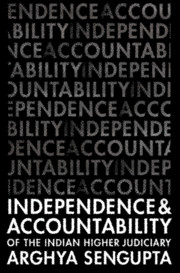Book contents
- Frontmatter
- Dedication
- Contents
- Acknowledgements
- List of Abbreviations
- List of Cases
- List of Statutes
- 1 Introduction
- PART I THE INDIAN EXPERIENCE
- 2 Pre-Tenure Questions: Appointments to the Higher Judiciary
- 3 In-Tenure Questions: Mechanisms for Judicial Discipline
- 4 Post-Tenure Questions: Post-Retirement Appointments of Judges by Government
- PART II A CONCEPTUAL ANALYSIS
- PART III TYING THE STRANDS
- Epilogue: The Moment the Judiciary Came Out
- Appendix Post-Retirement Employment of Judges in Government-Appointed Positions
- Bibliography
- Index
2 - Pre-Tenure Questions: Appointments to the Higher Judiciary
from PART I - THE INDIAN EXPERIENCE
Published online by Cambridge University Press: 26 April 2019
- Frontmatter
- Dedication
- Contents
- Acknowledgements
- List of Abbreviations
- List of Cases
- List of Statutes
- 1 Introduction
- PART I THE INDIAN EXPERIENCE
- 2 Pre-Tenure Questions: Appointments to the Higher Judiciary
- 3 In-Tenure Questions: Mechanisms for Judicial Discipline
- 4 Post-Tenure Questions: Post-Retirement Appointments of Judges by Government
- PART II A CONCEPTUAL ANALYSIS
- PART III TYING THE STRANDS
- Epilogue: The Moment the Judiciary Came Out
- Appendix Post-Retirement Employment of Judges in Government-Appointed Positions
- Bibliography
- Index
Summary
Appointment of judges in India has been the site of the most fractious battles over the independence of the higher judiciary. To provide a coherent account of this narrative, this chapter is divided into five sections. Section 2A deals with the constitutional position on judicial appointments as determined by the Constituent Assembly. Section 2B analyses the constitutional practice in the post-independence phase of appointments led by the executive. Section 2C deals with constitutional adjudication, analysing the three seminal cases pertaining to judicial appointments— SP Gupta v. Union of India (hereinafter ‘ Gupta ’); SCAORA and In re: Presidential Reference (hereinafter ‘ Presidential Reference ’), with specific focus on critiquing the collegium method of appointment that is in use at present. The consequences of such constitutional adjudication are highlighted through a case study of the proposal to appoint Justice Dinakaran as a judge of the Supreme Court of India. The case study is not intended to serve as a generalisable example; nonetheless, it is illustrative of the grave deficiencies from which the collegium system suffers. Section 2D analyses how the Supreme Court struck down the NJAC in the NJAC Case, thereby thwarting a parliamentary attempt to reform the process of judicial appointments. The last, Section 2E, deals with developments relating to the memorandum of procedure post the NJAC Case which have characterised the stalemate between the executive and the judiciary over judicial appointments. It also looks at the internal dissensions within the judiciary, led by Justice Chelameswar advocating for reform and greater transparency. Together, these sections analyse the legal basis of the different systems of appointment that have been used as well as identify the conceptual questions that the operation of such systems raise.
CONSTITUTIONAL POSITION: THE CONSTITUENT ASSEMBLY ON JUDICIAL APPOINTMENTS
Debates in the Constituent Assembly regarding appointments to the higher judiciary were brief. However in the discussions that took place, there was a keen perception of the ends which had to be achieved—the independence of the judiciary and safeguarding the dignity of the institution, the interests to be accommodated—a balance between governmental oversight and judicial autonomy in administration, a sharp awareness of the constitutional position in other jurisdictions and equally a realisation of the need to institute a system that would be effective in India's political culture.
- Type
- Chapter
- Information
- Publisher: Cambridge University PressPrint publication year: 2019

